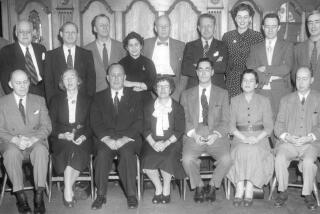MAD ABOUT THE FIFTIES: The Best of the Decade.<i> By “The Usual Gang of Idiots</i> .<i> “ Compiled by Grant Geissman</i> .<i> Little, Brown: 288 pp., $19.95</i>
I lost my virginity one night in 1958 on a carpet in the publisher’s office at Mad magazine. Since I was a gopher and freelance writer for Mad and still lived with my parents, Bill Gaines had befriended me with a key to his office. That’s where I brought my date, but to open the convertible sofa would have interfered with our compulsive spontaneity. Copies of Casket and Sunnyside, the magazine of the funeral industry, were on Gaines’ coffee table. Original paintings of his famous horror-comic-book characters--the Old Witch, the Crypt Keeper, the Vault Keeper--were hanging on the walls. And there was a framed portrait of Alfred E. Neuman, Mad’s gap-toothed young mascot, whose entire philosophy consisted of “What--Me Worry?” He was watching over me while I lost my sexual innocence, just as he had been watching over a whole generation while they were losing their cultural innocence.
Now an anthology, “MAD About the Fifties” by “the usual gang of idiots,” has been published on the heels of anthologies from the ‘60s, ‘70s and ‘80s. Its countercultural roots burst with boomer nostalgia.
Much of the humor in “MAD About the Fifties” seems corny and superficial in retrospect, but the ‘50s so reeked with repression (McCarthyism), piety (Norman Vincent Peale’s “Power of Positive Thinking”) and blandness (Snooky Lansom singing “It’s a Marshmallow World” on “The Lucky Strike Hit Parade”) that there was a hunger for almost any kind of rebellion. Something, somebody, had to break through this thick haze of conformity that had dulled our national consciousness. And some did. In literature, there were the Beat writers and Norman Mailer’s “The White Negro” (which today, of course, would be called “The Caucasian African-American”). In the movies, there was Marlon Brando in “The Wild One.” In music, Elvis Presley. And, in the media--before there was National Lampoon or Spy, before there was “Laugh-In” or “Saturday Night Live”--there was Mad, serving to unite those who had previously felt that they were the only Martians on their block.
Mad was originally launched as a comic book in 1952, then became a magazine in 1955, but Grant Geissman in his foreword presents a bit of blatant misinformation: “[Mad Editor Harvey] Kurtzman had been entertaining a job offer from Pageant, and he told Gaines he was thinking of leaving. To keep Kurtzman in the fold, Gaines offered to let him reinvent Mad as a 25-cent slick, an offer Harvey readily accepted.”
The facts differ. It was bad enough when the Boy Scouts officially sponsored a project to confiscate comic book collections because they were reputed to breed polio bacteria, but then in 1954 psychiatrist Frederic Wertham wrote a book, “Seduction of the Innocent,” blaming the rise of juvenile delinquency on comic books, and the resulting hysteria produced newsstand boycotts and comic book burnings. The Senate Judiciary Committee conducted special hearings to investigate the need for legislation to ban certain kinds of comic books. To avoid government censorship, Gaines and his business manager, Lyle Stuart, organized the Comics Magazine Assn. of America, requiring a stamp of approval on the cover of every comic book, guaranteeing that the contents were “wholesome, entertaining and educational.” Rather than risk the loss of distribution, publishers toned down their material to meet those subjective standards. Ironically, since the association didn’t want any American institutions ridiculed, Mad could not possibly join and dilute its trademark irreverence.
Stuart suggested that they change it from a comic book to a magazine so that it wouldn’t be subject to the Comics Code. Gaines said he didn’t know anything about magazines, but Stuart assured him they could learn together. Meanwhile, Kurtzman resigned from Mad because he had been promised the last third of every issue of the mainstream Pageant. Stuart talked Kurtzman out of leaving Mad and talked Gaines into publishing it as a magazine.
After five issues, Kurtzman demanded 51% of Mad’s stock. Stuart advised Gaines to fire Kurtzman.
“But,” Gaines asked, “what’ll I do for an editor?”
Stuart replied, “Hire Al Feldstein. He did a good job with Panic [Mad’s sister humor comic book].”
This recommendation seemed strange, inasmuch as Stuart was not speaking with Feldstein. Gaines fired Kurtzman, who flew into the waiting arms of Playboy Publisher Hugh Hefner to start a humor magazine called Trump, and Feldstein became Mad’s editor. One afternoon, Stuart passed Gaines and Feldstein in the corridor. True to form, Stuart greeted Gaines but ignored Feldstein.
“Just because Lyle got you the job,” Gaines explained, “don’t expect him to say hello to you.”
As a comic book, Mad started out by parodying other comic books, altering names to avoid lawsuits. “Superduperman” wants to don his costume in a phone booth only to find it’s already occupied. “Starchie” wields a wooden rubber band gun loaded with linoleum squares. “The Lone Stranger” featured Pronto, a stereotypical drunk Indian. “Bat Boy and Rubin” defended itself in advance: “Notice! This story is a lampoon!” As a magazine, Mad parodied other magazines (“Bitter Homes and Gardens,” with articles like “Convert your spare bedroom into a basement”), movies (“Seven Itchy Years”) and TV (“The Ed Suvillan Show,” which included a full-page faux summons for causing “public scorn and ridicule”). “Baseball Is Ruining Our Children” was credited to “Frederick Werthless, M.D.”
Sexual behavior was taboo, though, because “my mother reads the magazine,” Gaines told me.
I complained, “But she’s not a typical reader,” and he replied, “No, but she’s a typical mother.”
And the targets were relatively tame. I pitched adult concerns--racism, the Cold War, nuclear testing--in vain. Circulation had reached a million, and Gaines preferred to continue aiming Mad at teenagers.
I said, “I guess you don’t want to change horses in midstream.”
Gaines’ minimalist response: “Not when the horse has a rocket up its ass.”
Mad eventually reached a circulation of 2.5 million, in the process becoming more willing to play with controversy. In 1958, Mad published an ad parody of “Sailems” with an anti-smoking theme. A Mad “First Reader” included this confession: “I am in the first grade. My teacher is Miss Furd. I tell the school board Miss Furd is a Commie. The school board investigates Miss Furd. Miss Furd is through in this town.” Elsewhere, a boy and a girl were hanging around with a junior biker, smoking a “reefer” and muttering, “Crazy, man.” And in a Don Martin cartoon strip, a man ran off with a blowup doll.
But what got Mad into trouble were its covers. In a 1954 cover, Mona Lisa was holding a copy of Mad, and Catholic officials thought it was the Virgin Mary. Next year, the infamous mottled black-and-white composition-book cover was criticized in editorials for encouraging kids to sneak Mad into class.
Indeed, one legacy of Mad is a certain legitimization of brattiness, enhanced by technology. Recently, a computer hacker was interviewed in a radio documentary, “This American Life.” His group had probed NASA, NSA and TRW. They had raised the pay of a lowly McDonald’s employee and learned what John Gotti owned. They called Julia Roberts at home, Queen Elizabeth at her palace and Bill Gaines at home. “He was going through some rough times,” the hacker confessed, “and we were calling him for about two weeks, and he went kind of crazy. He was just really stressed out. We kept phoning him, and finally we started harassing him. We made fun of him and laughed at him and called him Alfred E. Neuman and ridiculed him, and he got so mad at us. We used to keep calling and screwing around with him, and then one day we read in the paper that he died. The day after we called him, he passes away, and we’re like, ‘Yo, did we kill him? I hope not.’ They said he had a nervous breakdown. ‘Oh, my God, I think we contributed to his demise; we better not tell anybody this.’ But then we realized there were probably other factors and not just a kid calling him on the phone.” In any case, it was a karmic twist that Mad’s usual gang of idiots would never have imagined.
More to Read
Sign up for our Book Club newsletter
Get the latest news, events and more from the Los Angeles Times Book Club, and help us get L.A. reading and talking.
You may occasionally receive promotional content from the Los Angeles Times.









